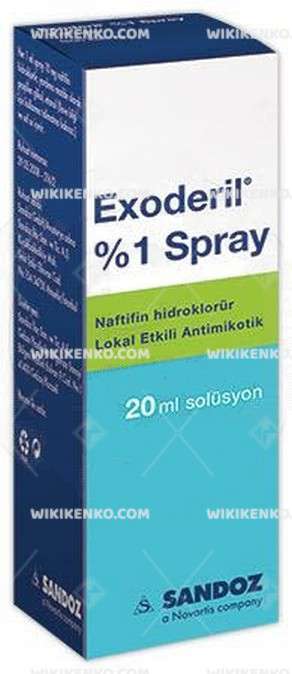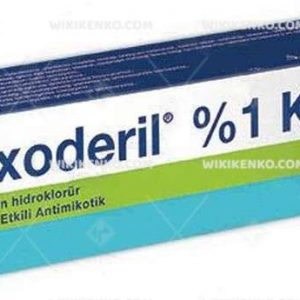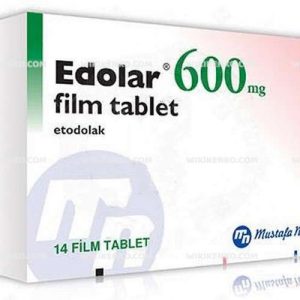Exoderil Spray
Exoderil Spray emerges as a formidable solution in the realm of topical antifungal medications. This therapeutic marvel boasts naftifine hydrochloride as its active ingredient, delivering precise and targeted relief for a spectrum of skin fungal infections.
| Dosage form | |
|---|---|
| Pack size | |
| Potency | %1 20Ml |
| Manufacturer | |
| Origin | |
| Generic Name (Ingredient) | Each 1 Ml Spray Contains 10 Mg Of Naphtifine Hydrochloride. |
Assuming your emergency circumstances for this product, visit Urgent Quotation page. Besides, for any pharmaceutical questions, please ask us in the comments section.
Description
Demystifying Naftifine Hydrochloride
At the core of Exoderil Spray lies naftifine hydrochloride, an allylamine antifungal agent with a dual modus operandi. Its prowess lies in the ability to either eradicate fungi or impede their growth and proliferation, depending on the specific fungal strain encountered. Furthermore, this versatile compound lends Exoderil an additional dimension—it exhibits anti-inflammatory properties, contributing to a comprehensive approach in combating fungal infections.
Exoderil Spray Applications
Exoderil Spray finds its niche in addressing fungal infections triggered by dermatophytes and Candida, while also extending its therapeutic reach to Pityriasis versicolor. Its effectiveness extends across various strains of fungi, encompassing skin fungi, yeast fungi, mold fungi, and other fungal varieties.
Usage Guidelines
For optimal results, it is imperative to adhere to the prescribed usage guidelines for Exoderil Spray. This formulation is exclusively for external use and should not be applied to open wounds or come into contact with the sensitive ocular region. Available in convenient 20 ml packages, it serves as a potent weapon against fungal intruders, with a primary focus on fungal infections of the feet. These infections often manifest between the toes, on the soles (evidenced by redness, scaling, swelling, or pruritic blisters), and even on the nails.
Precautions
Prior to embarking on an Exoderil Spray regimen, it is prudent to initiate a dialogue with your healthcare provider or pharmacist. This precautionary step is especially crucial if you possess a known allergy to naftifine or any of the other components within this medication. It is equally vital to disclose any concurrent medications you may be taking. For expectant mothers and breastfeeding individuals, seeking counsel from a healthcare professional is paramount before embracing this treatment.
Side Effects
Exoderil Spray is generally well-tolerated, a testament to its safety profile. However, akin to any medicinal intervention, it may unveil side effects in a subset of individuals. Among these, a burning sensation at the application site is the most commonly reported side effect. Should you experience any adverse effects while on an Exoderil Spray regimen, prompt consultation with your healthcare provider or pharmacist is advisable. To minimize the risk of side effects, meticulous adherence to usage instructions and precautions is recommended.
Ingredients
Exoderil Spray unveils its secret weapon, the formidable naftifine hydrochloride, as the star of the show. This allylamine antifungal powerhouse orchestrates the offensive against fungi, adapting its strategy depending on the fungal strain encountered. While naftifine hydrochloride takes center stage, information about additional ingredients remains elusive. For a more comprehensive understanding of this medication’s components, consulting a healthcare professional is the recommended course of action.
Deciphering the Cream vs. Spray Conundrum
For those navigating the choice between Exoderil cream and Exoderil spray, it’s important to note that both formulations share the same active ingredient—naftifine hydrochloride. The primary distinction often lies in their formulation and application methodology. Creams tend to be thicker and offer enhanced moisturization, ideal for specific localized treatment. Conversely, sprays are lighter, facilitating broader application to larger areas of the skin. To make an informed decision, adhering to the usage instructions provided with each product and seeking guidance from a healthcare professional is pivotal.
Conclusion
In conclusion, Exoderil Spray, armed with naftifine hydrochloride, emerges as a formidable contender in the realm of antifungal solutions. Its multifaceted approach, encompassing fungal eradication and anti-inflammatory properties, renders it a potent weapon against an array of skin fungal infections. While its safety record is commendable, adherence to precautions and consultation with healthcare professionals remains paramount for a seamless and effective therapeutic journey. Unlock the potential of Exoderil Spray, your ally in the battle against fungal intruders.
Use the form below to report an error
Please answer the questions as thoroughly and accurately as possible. Your answers will help us better understand what kind of mistakes happen, why and where they happen, and in the end the purpose is to build a better archive to guide researchers and professionals around the world.
The information on this page is not intended to be a substitute for professional medical advice, diagnosis, or treatment. always seek the advice for your physician or another qualified health provider with any questions you may have regarding a medical condition. Always remember to
- Ask your own doctor for medical advice.
- Names, brands, and dosage may differ between countries.
- When not feeling well, or experiencing side effects always contact your own doctor.
Cyberchondria
The truth is that when we’re sick, or worried about getting sick, the internet won’t help.
According to Wikipedia, cyberchondria is a mental disorder consisting in the desire to independently make a diagnosis based on the symptoms of diseases described on Internet sites.
Why you can't look for symptoms on the Internet
If diagnoses could be made simply from a textbook or an article on a website, we would all be doctors and treat ourselves. Nothing can replace the experience and knowledge of specially trained people. As in any field, in medicine there are unscrupulous specialists, differences of opinion, inaccurate diagnoses and incorrect test results.





Reviews
There are no reviews yet.